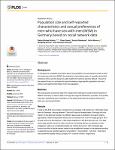Population size and self-reported characteristics and sexual preferences of men-who-have-sex-with-men (MSM) in Germany based on social network data
Scholz, Stefan Michael
Damm, Oliver
Elkenkamp, Svenja
Marcus, Ulrich
Greiner, Wolfgang
Schmidt, Axel Jeremias
Background
In the absence of detailed information about the population size and behaviour data of men-who-have-sex-with-men (MSM), the estimation of prevalence rates of sexually transmitted infections (STIs) and the design of public health interventions become difficult. The aim of the present study is to estimate the lower boundary of age-specific population sizes and retrieve self-reported information from this population.
Methods
We used publicly accessible data from a large online dating and social network website for MSM in Germany to retrieve data on the age and regional distribution of profiles. The profiles were also stratified by their information on the preferred position during anal intercourse, safer sex, and sexual identity.
Results
A total of 464,873 user profiles correspond to an average 15.2 profiles per 1,000 male inhabitants in Germany, varying between 7.6 and 45.6 across federal states. Although the information on the absolute numbers for different age groups is limited by the search engine, age-specific relative frequencies were found to increase from 12.9 in the age group of 18 to 20 year olds to 24.6 profiles per 1,000 male inhabitants in the 28 to 30 year olds. The data shows age-specific trends for safer sex with an increasing easiness of reporting “never” engaging in safer sex or stating that safer sex “needs discussion” with increasing age. Around one third of profile owners stated to be versatile with respect to the preferred position in anal intercourse. All other options (“only bottom”, “more bottom”, “only top”, “more top”) were preferred equally likely by roughly 10% of profile owners, respectively.
Conclusions
Online social network or dating sites can provide some information about specific populations in the absence of other data sources. The presented results are the first to report age-specific rates of MSM per 1,000 male inhabitants in Germany and may be useful to estimate age-specific prevalence or incidence rates as well as to inform health promotion activities and modelling studies for MSM in Germany.

